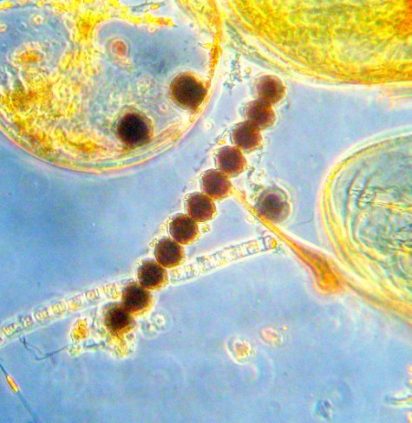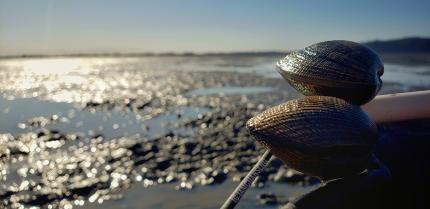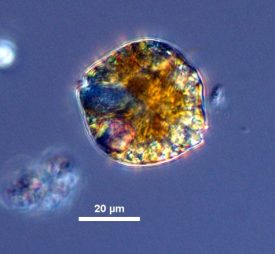Blooming Concerns
Spring is in full bloom here in Washington State, and it’s not just the cherry blossom trees coming to life. Coastal waters are, too, with blooms of a more dangerous kind. As temperatures rise and daylight stretches longer into the evening, Washington’s coastal waters are beginning to stir with microscopic life, some of which pose serious threats to marine ecosystems and human health. Among the most notorious of these is Alexandrium catenella, a toxic dinoflagellate responsible for harmful algal blooms (HABs) that lead to paralytic shellfish poisoning (PSP). While these so-called “red tides” may color the water with an eerie beauty, their consequences ripple through fisheries, aquaculture, and coastal communities.

Alexandrium catenella is a species of photosynthetic algae typically present in low numbers in the Puget Sound. Its spherical cells are reddish brown and can discolor coastal waters in high concentrations, creating what is known as a “red tide”. Algal bloom events occur when conditions are right for rapid growth and accumulation of cells in a particular location.
Similar to other dinoflagellate species, Alexandrium has two main life history phases: an active planktonic phase and a dormant cystic phase. During their planktonic phase, A. catenella is motile, using two flagella that make it capable of adjusting its position in the water column for optimal light and growth conditions. With abundant nutrients and ideal environmental conditions, cells will reproduce exponentially through simple division. A single cell of A. catenella can divide into several hundred cells within weeks. However, once conditions are no longer favorable for rapid growth, Alexandrium forms gametes that fuse into specialized cells called planozygotes. The zygote cell essentially prepares for “hibernation” by thickening its cell wall and condensing its cytoplasm to enter the dormant cyst phase of its life cycle. Carried by currents, the cysts eventually sink and settle on the seafloor, where they lie dormant until the right conditions trigger germination. This life cycle strategy allows A. catenella to endure cold winter temperatures and persist year after year.
Spring marks the beginning of the bloom season below the surface waters of Puget Sound. As water temperatures rise and sunlight increases, these shifting environmental conditions act as a signal to Alexandrium cysts lying dormant on the seafloor. Like seeds sensing the start of the growing season, the resting cysts will germinate under the right combination of light, temperature, and oxygen. In Puget Sound, this process typically begins in late spring to early summer, when conditions are optimal for growth. Once the cysts hatch, the newly released motile cells enter the water column, where they can rapidly reproduce if temperature, salinity, and nutrient levels also align in their favor.
“Like seeds sensing the start of the growing season, the resting cysts will germinate under the right combination of light, temperature, and oxygen.”
Seasonal patterns of warm air and water temperatures, as well as lower salinity levels, have been associated with Alexandrium catenella blooms. However, forecasting when and where a harmful algal bloom will occur is very difficult due to the complex interplay between environmental variables, from wind patterns, nutrient fluxes, and freshwater runoff to broader climate conditions. Researchers are investigating which environmental factors most strongly influence cyst germination and bloom development.
Not all strains of Alexandrium catenella are inherently toxic, and strains within the species can exhibit varying levels of toxin production depending on environmental conditions. The amount of toxin produced by A. catenella is also influenced by environmental factors. This makes monitoring for toxicity challenging since the presence of A. catenella in the water does not always warrant fishery closures.

In Washington State, Alexandrium is a harmful algal bloom species of concern for its ability to produce paralytic shellfish toxins (PST). Under certain conditions, the species produces saxitoxin, which can be fatal for marine wildlife, cultured shellfish, and even humans. A. catenella enters the food web when it’s ingested by filter feeders such as shellfish or other invertebrates, which are in turn consumed by larger species such as mammals and birds. Shellfish are culturally significant to the food sovereignty and traditions of Coast Salish peoples. They are harvested for subsistence, commercial, and recreational purposes, and represent a major sector of Washington’s coastal economy. The bioaccumulation of saxitoxin in filter-feeding shellfish poses health risks to human consumers. Paralytic Shellfish Toxin-related illnesses caused by Alexandrium catenella blooms are tracked by the Washington Department of Health (WDOH). Symptoms of this Paralytic Shellfish Poisoning (PSP) range from headaches and nausea, to vomiting, numbness of the lips and mouth, muscle paralysis, and even mortality depending on the concentration consumed.
Historically, harmful algal blooms of Alexandrium catenella were prevalent within Sequim Bay and Discovery Bay in the northern Puget Sound region during the 1950s and 1960s. These blooms extended south in the 1970s and 1980s to inner regions of Puget Sound. Harmful algal bloom events leading to PSP toxins in Washington shellfish and crab have been variable from year to year, indicating that seasonal and annual environmental conditions have a role in their occurrence. However, despite the interannual variability, the frequency of high PSP toxin events detected by the WDOH has been increasing since 1957. The combination of warm air and water temperatures has correlated with PSP toxin accumulation in mussels.
“However, despite the interannual variability, the frequency of high PSP toxin events detected by the WDOH has been increasing since 1957.”
When Alexandrium blooms cause toxicity in a region, specific shellfish fisheries are required to temporarily close until toxin levels drop. Fishery closures are based on toxin monitoring action levels set by the U.S. Food and Drug Administration (FDA) of 80 micrograms per 100 grams of shellfish tissue. Closures can have significant effects on commercial, recreational, and subsistence harvest. However, episodes of high biotoxin levels are unpredictable in time or space due to the interaction of multiple poorly understood environmental factors. The WDOH Office of Shellfish Safety and Water Protection regularly monitors biotoxin levels in both recreational and commercial shellfish areas in Puget Sound using a Sentinel Mussel Monitoring Program. Mussels are a “sentinel” species used to detect when PSP toxins are increasing in a given area because they generally accumulate toxins more rapidly than other shellfish species. These mussels are deployed in suspended cages and routinely collected to test for PSP toxin accumulation.

As climate patterns shift toward increased warming and coastal conditions become more variable, the need for proactive monitoring and forecasting is becoming more critical. Scientists and public health managers in Washington State are collaborating to better understand the drivers of Alexandrium catenella harmful algal blooms. By studying environmental conditions and habitats favorable for blooms, tracking cyst “seed banks”, and monitoring PSP toxin levels in real time using mussels as a sentinel species, experts are actively improving early warning systems. Protecting shellfish consumers—whether commercial, recreational, or cultural—requires ongoing research, interagency coordination, and adaptive management in the face of a changing environment. While we may not yet be able to prevent these blooms, enhancing our ability to predict and respond to them is a vital step toward reducing their impact. The best way to check if it’s safe to collect shellfish from local beaches is to visit the Washington Shellfish Safety Map.